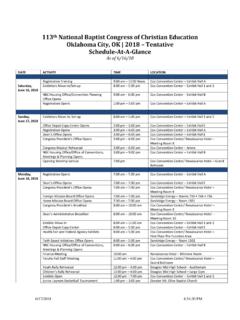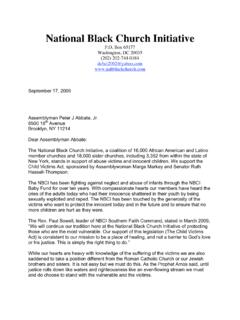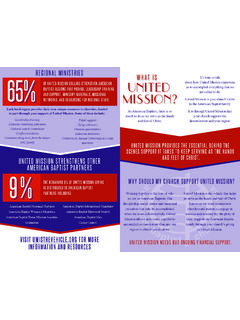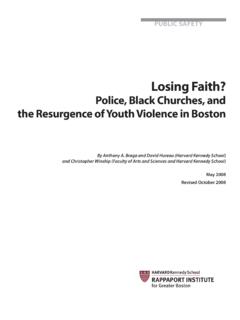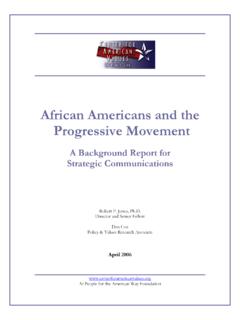Transcription of B.202 Report from Educate a Child Initiative - pma.pcusa.org
1 PRESBYTERIAN MISSION AGENCY BOARD April 27-29, 2016 World Mission Ministry Area 1 ITEM FOR INFORMATION Report FROM Educate A Child Initiative The Educate a Child , Transform the World Initiative continues in collaboration with World Mission (international component) and Compassion, Peace and Justice ( national component). The goal of the Initiative is to reach one million children in the and internationally, with practical strategies to improve their educational opportunities, focusing especially on vulnerable children. We will give witness to a coherent and effective Christian mission response to contemporary educational needs in ways that maximize the unique capacities of individuals, congregations, and the Presbyterian Mission Agency.
2 International The World Mission campaign was launched at the 221st General Assembly in 2014, as the first Initiative to address the root causes of global poverty. It is led by Frank Dimmock, the catalyst addressing the root causes of global poverty. The goal is to work collaboratively with . Presbyterians and global partners to strengthen the quality of education programs in order to provide access to effective, efficient, and equitable learning for all children. Campaign activities have included: On-going communication with global and ecumenical partners engaged in education; Mapping the education landscape ( needs, resources, actors); Raising awareness and informing PC(USA) constituents of ways to connect and support the campaign; Facilitating support to specific global and partner educational programs.
3 Presentations have been made in many partner network meetings, Presbytery meetings, and other church -sponsored events ( Big Tent, Presbyterian Women Gathering, conferences). Information has been communicated to constituents via a webinar ( ), Facebook page ( ), PC(USA) website ( ) and blog posts ( ). The campaign has also been featured in several publications, including Mission Crossroads magazine, Horizons magazine, Presbyterians Today magazine and the Presbyterian News Service. Financial support for global education projects has been raised through extra commitment opportunity (ECO) accounts to fund partner initiatives. The international campaign has five principal objectives: 1. Assist partner education programs to develop and/or strengthen pre-primary (early childhood) programs.
4 This is being done in Ethiopia, Malawi, Guatemala, Bangladesh and the Philippines. 2. Strengthen teacher training and mentoring opportunities. Quality education depends on the availability of trained teachers at all levels. PC (USA) mission co-workers are helping partners in South Sudan, Madagascar, Thailand and the Democratic Republic of Congo (DRC) to train and equip teachers. 3. Increase awareness and participation of parents and community members in support of children s education and improved school environments. Committees and associations that encourage active involvement are being established in South Sudan, the Philippines and other places. PRESBYTERIAN MISSION AGENCY BOARD April 27-29, 2016 World Mission Ministry Area 2 4. Improve school infrastructure and management.
5 This activity has increased the number of children who can access a safe and healthy school environment. Great progress has been made with partners in the DRC through the Build Congo Schools program. 5. Enroll and keep kids in school (especially girls). There are many factors, including destitution, family and social situations and cultural traditions which impact school attendance. Several strategies have been developed to improve attendance and protect the safety of all children and teachers. Measuring global campaign impact quantitatively continues to be a challenge. Learning is lifelong, contextual and complex. Direct variables included in the World Mission education campaign goal count include: number of children enrolled in global partner (GP) preschool programs; number of primary school children in GP schools that have been rebuilt or upgraded (including hygiene facilities) with PC(USA) support; number of children in classes taught by teachers that have been mentored by PC(USA) mission co-workers (MCWs) or have adopted new learning methods ( evidence-based methods of instruction (EBMI)); and number of scholarship recipients in GP schools.
6 Indirect variables monitored include: number of children in GP schools that have been upgraded with non-PC(USA) support; number of children in GP schools that have received educational resources ( text books and teaching materials); improvements in teacher staffing and attendance at GP schools; GP education departments that demonstrate improvements in EdInfo Systems*; increased support for MCWs and extra-commitment opportunity (ECO) accounts related with GP education programs. *EdInfo relates to education information collected routinely on behalf of government ministries. national Initial conversations about the national component of the Initiative began in December 2014, during which time Rev. Dr. Eileen Lindner was hired as consultant and the proposed direction and foci of the Initiative were tested with a team of denominational leaders, including representatives from Presbyterian Women (PW), the Association of Presbyterian Christian Educators (APCE), the Advisory Committee on Social Witness Policy (ACSWP), the Presbyterian Child Advocacy Network (PCAN, part of PHEWA), the Moderator of the 221st General Assembly, and urban ministers engaged in innovative educational work.
7 Based on these initial conversations and feedback from these leaders, the national Initiative developed two foci around which to concentrate its efforts: strengthening early childhood education and reducing the adolescent dropout rate. A national staff team was assembled, led by convener Rev. Alonzo Johnson, Mission Associate for Peacemaking, and including staff from the Office of Public Witness, ACSWP and Funds Development. Since its April 2015 launch, the national component has sought out and lifted up the stories of Presbyterian congregations and organizations engaged in direct action and advocacy related to education. Current information and resources are available on the national component s website ( ). The Initiative has facilitated workshops, presentations, and conversations in congregations, presbyteries, and networks such as PW, APCE, the national black Presbyterian Caucus, the Presbyterian Racial Ethnic Schools and Colleges Presidents Roundtable.
8 The Initiative has developed and continues to develop PRESBYTERIAN MISSION AGENCY BOARD April 27-29, 2016 World Mission Ministry Area 3 resources to equip individuals and congregations, including an Educate a Child Toolkit and webinars. In July 2015, the national staff team convened a group of Presbyterians at the Children Defense Fund s Proctor Institute for Child Advocacy to continue to shape, plan, and envision the Initiative . Using the metric of one million children, the team will assess in four years the extent to which this Initiative has enabled children to live the lives for which they were created. In addition to this, they will seek to recover a sense of advocacy for children as a central example of Christian life and witness within the PC (USA).
9 As such, the team will seek to identify, elevate, celebrate, and encourage the replication of the best congregationally-based strategies. Through electronic and social media, they also intend to initiate a vigorous national conversation and fellowship among Presbyterians regarding how best to live out this mission to children as a demonstration of the hope of the Gospel. The national team is also intentional about encouraging, engaging, and training leaders of all ages and regions to serve as advocates for the education of children and enable their engagement with other such networks, both secular and religious. In addition to this, they want to help give voice to national public policy debates around educational issues and funding, and facilitate engagement in state and local reform efforts in public education.
10 The Educate a Child Initiative also supports congregations as they collect the Pentecost offering, where 40 percent of the offering remains with congregations, which would allow them to train and equip leaders in their midst for the mission of education, and to invest in the education of those children most at need in their local communities. World Mission and Compassion, Peace and Justice co-sponsored a workshop at Big Tent in 2015 that analyzed and explored ways that education can be instrumental in alleviating poverty ( ). Recently, more joint discussions have been held with colleagues from the Urban Ministry Roundtable, Presbyterian Disaster Assistance and concerned pastors and clergy on the ground to create ways to collaborate and partner with individuals to address through direct action and/or advocacy, the impact long-term lead exposure and poisoning will have on the children of Flint.


